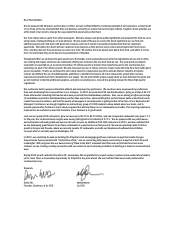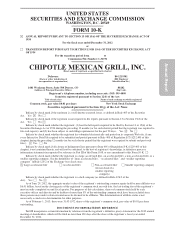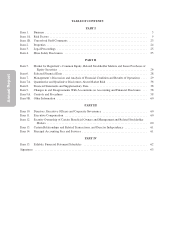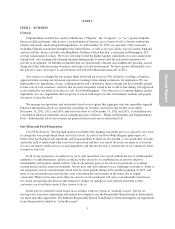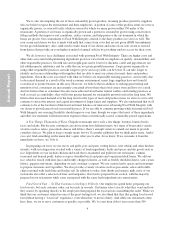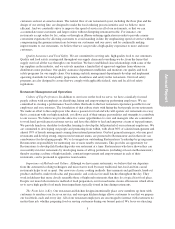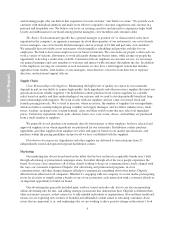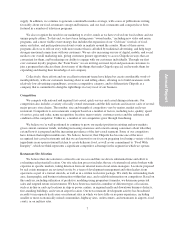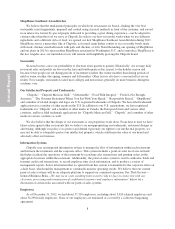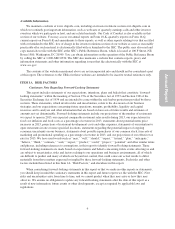Chipotle 2012 Annual Report Download - page 5
Download and view the complete annual report
Please find page 5 of the 2012 Chipotle annual report below. You can navigate through the pages in the report by either clicking on the pages listed below, or by using the keyword search tool below to find specific information within the annual report.
PART I
ITEM 1. BUSINESS
General
Chipotle Mexican Grill, Inc. and its subsidiaries (“Chipotle”, the “Company”, or “we”) operate Chipotle
Mexican Grill restaurants, which serve a focused menu of burritos, tacos, burrito bowls (a burrito without the
tortilla) and salads, made using fresh ingredients. As of December 31, 2012, we operated 1,410 restaurants,
including Chipotle restaurants throughout the United States, as well as five in Canada, five in London, England,
and one in Paris, France, and also one ShopHouse Southeast Asian Kitchen, a restaurant in Washington, D.C.
serving Asian-inspired cuisine. We focus on trying to find the highest quality ingredients we can to make great
tasting food; on recruiting and retaining top performing people to ensure that the restaurant experience we
provide is exceptional; on building restaurants that are operationally efficient and aesthetically pleasing; and on
doing all of this with increasing awareness and respect for the environment. We have grown substantially over
the past five years, and expect to open between 165 and 180 additional restaurants in 2013.
Our vision is to change the way people think about and eat fast food. We do this by avoiding a formulaic
approach when creating our restaurant experience, looking to fine-dining restaurants for inspiration. We use
high-quality raw ingredients, classic cooking methods and a distinctive interior design and have friendly people
to take care of each customer—features that are more frequently found in the world of fine dining. Our approach
is also guided by our belief in an idea we call “Food With Integrity.” Our objective is to find the highest quality
ingredients we can—ingredients that are grown or raised with respect for the environment, animals and people
who grow or raise the food.
We manage our operations and restaurants based on six regions that aggregate into one reportable segment.
Financial information about our operations, including our revenues and net income for the years ended
December 31, 2012, 2011, and 2010, and our total assets as of December 31, 2012 and 2011, is included in our
consolidated financial statements and accompanying notes in Item 8, “Financial Statements and Supplementary
Data.” Substantially all of our revenues are generated and assets are located in the U.S.
Our Menu and Food Preparation
Food With Integrity. Serving high quality food while still charging reasonable prices is critical to our vision
to change the way people think about and eat fast food. As part of our Food With Integrity philosophy, we
believe that purchasing fresh ingredients and preparing them by hand are not enough, so we spend time on farms
and in the field to understand where our food comes from and how it is raised. Because our menu is so focused,
we can concentrate on the sources of each ingredient, and this has become a cornerstone of our continuous effort
to improve our food.
In all of our restaurants, we endeavor to serve only meats that were raised without the use of subtherapeutic
antibiotics or added hormones, and in accordance with criteria we’ve established in an effort to improve
sustainability and promote animal welfare. One of our primary goals is for all of our restaurants to continue
serving meats raised to meet our standards, but we have and will continue to face challenges in doing so. Some of
our restaurants served conventionally raised beef for short periods during 2012 and the beginning of 2013, and
more of our restaurants may periodically serve conventionally raised meats in the future due to supply
constraints. When we become aware that one or more of our restaurants will serve conventionally raised meat,
we clearly and specifically disclose this temporary change on signage in each affected restaurant so that
customers can avoid those meats if they choose to do so.
In the past we referred to meat raised in accordance with our criteria as “naturally raised,” but we are
moving away from that terminology and instead have begun to use the Responsibly Raised brand to differentiate
our meat and other ingredients. We think the Responsibly Raised brand helps to better distinguish our ingredients
from other products labeled as “naturally raised.”
3
Annual Report


